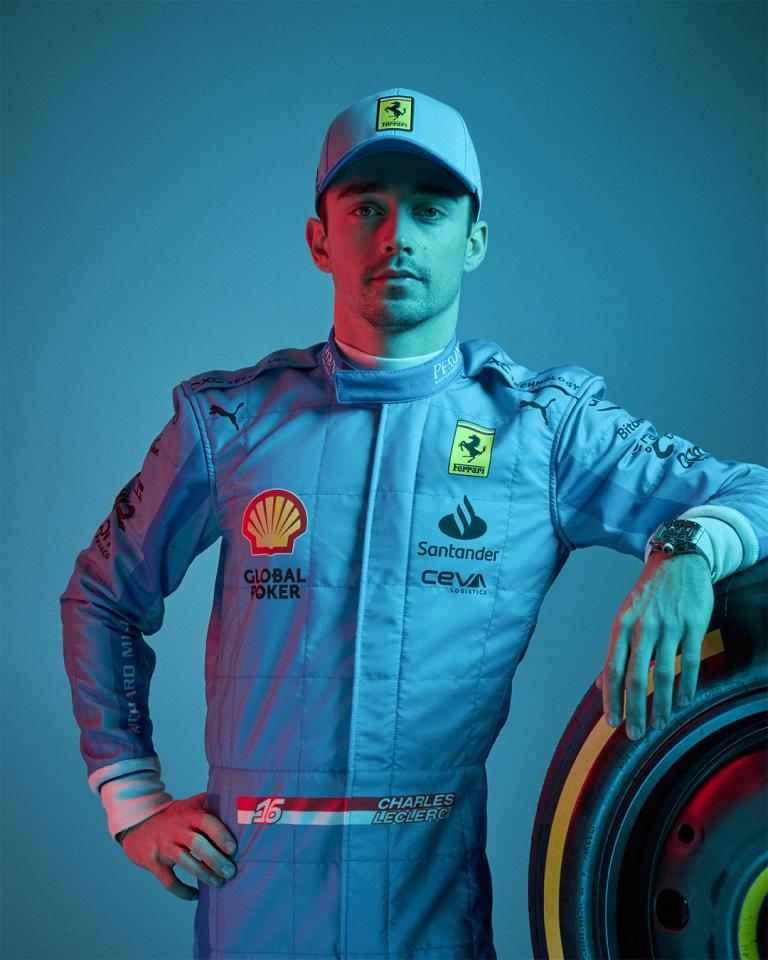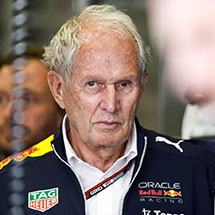Ferrari a présenté les combinaisons spéciales arborées par ses pilotes pour le Grand Prix de Miami. Le bleu est a l’honneur et la livrée de la SF-24 se fait désirer.





| Pos. | Pilote (Constructeur) | Temps |
|---|---|---|
| 1 | M.Max VERSTAPPEN (Red Bull) | 1:40:52.554 |
| 2 | L.Lando NORRIS (McLaren) | +13.773 |
| 3 | S.Sergio PÉREZ (Red Bull) | +19.160 |
| 4 | C.Charles LECLERC (Ferrari) | +23.623 |
| 5 | C.Carlos SAINZ (Ferrari) | +33.983 |
| 6 | G.George RUSSELL (Mercedes) | +38.724 |
| 7 | F.Fernando ALONSO (Aston Martin) | +43.414 |
| 8 | O.Oscar PIASTRI (McLaren) | +56.198 |
| 9 | L.Lewis HAMILTON (Mercedes) | +57.986 |
| 10 | N.Nico HÜLKENBERG (Haas) | +1:00.476 |
| Pos. | Pilote (Constructeur) | Points |
|---|---|---|
| 1 | Max VERSTAPPEN (Red Bull) | 110 |
| 2 | Sergio PÉREZ (Red Bull) | 85 |
| 3 | Charles LECLERC (Ferrari) | 76 |
| 4 | Carlos SAINZ (Ferrari) | 69 |
| 5 | Lando NORRIS (McLaren) | 58 |
| 6 | Oscar PIASTRI (McLaren) | 38 |
| 7 | George RUSSELL (Mercedes) | 33 |
| 8 | Fernando ALONSO (Aston Martin) | 31 |
| 9 | Lewis HAMILTON (Mercedes) | 19 |
| 10 | Lance STROLL (Aston Martin) | 9 |
| Pos. | Constructeur | Victoires | Points |
|---|---|---|---|
| 1 | Red Bull | 4 | 195 |
| 2 | Ferrari | 1 | 151 |
| 3 | McLaren | 0 | 96 |
| 4 | Mercedes | 0 | 52 |
| 5 | Aston Martin | 0 | 40 |
| 6 | RB F1 Team | 0 | 7 |
| 7 | Haas F1 Team | 0 | 5 |
| 8 | Williams | 0 | 0 |
| 9 | Alpine F1 Team | 0 | 0 |
| 10 | Sauber | 0 | 0 |
La petite bombe : Nico le Hulk Hülkenberg ne continuera pas chez Haas en 2025 !
La Scuderia Ferrari a officialisé son partenariat avec Hewlett-Packard a.k.a. HP. Ils deviennent donc sponsor titre de l'écurie italienne qui s'intitulera désormais Scuderia Ferrari HP.
It all starts in the garage, where we dare to dream and achieve. Today, @HP and @ScuderiaFerrari announce their historic title partnership.
— Scuderia Ferrari HP (@ScuderiaFerrari) April 24, 2024
We are thrilled to embark on a journey to empower people through technology and innovation and create meaningful connections worldwide 🏁… pic.twitter.com/X2b0GfiNrk


Jaguar a réaffirmé son engagement dans l'ère GEN4 de la Formule E jusqu'en 2030, marquant un tournant décisif dans sa collaboration avec la Formule E et la FIA. Cette décision souligne la convergence des objectifs à long terme des trois entités en matière de durabilité et d'innovation dans l'industrie automobile, tant sur les pistes qu'en dehors. Cette annonce historique met en lumière la volonté de Jaguar de se positionner comme un constructeur pionnier de la Formule E, pleinement engagé dans cette nouvelle phase du championnat.
La technologie GEN4 promet une avancée révolutionnaire dans les courses de véhicules électriques, avec des améliorations significatives en termes d'efficacité énergétique, de performance en course et de normes de sécurité. La nouvelle plateforme GEN4 introduira des caractéristiques telles qu'une capacité de régénération pouvant atteindre jusqu'à 700 kW et une puissance poussée jusqu'à 600 kW, équivalent à environ 816 chevaux. Ce bond technologique réaffirme l'engagement de Jaguar TCS Racing à développer des solutions de course durables tout en propulsant sa propre trajectoire technologique vers de nouveaux sommets.
Mercedes dévoile son nouveau Classe G électrique, le G580, une réinvention puissante du légendaire GELÄNDEWAGEN. Pesant 3085 kg, ce modèle offre une puissance impressionnante de 579 chevaux et développe un couple de 1164 Nm, permettant une accélération de 0 à 100 km/h en seulement 4,7 secondes.
Il est équipé d'une batterie de 116 kWh qui lui confère une autonomie estimée à 434 à 473 km selon le protocole WLTP, et jusqu'à 250 miles selon l'EPA. En seulement 15 minutes de charge rapide à 200 kW, le véhicule récupère jusqu'à 170 km d'autonomie.
Son coefficient de traînée est de 0.44, optimisant ainsi son efficacité énergétique. La batterie est protégée par une plaque de protection épaisse d'un pouce (2,5 cm) et pèse 58 kg. Parmi les fonctionnalités modernes, il inclut un écran tactile de 12,3 pouces et peut traverser des cours d'eau jusqu'à 85 cm de profondeur, soit 15 cm de plus que la version à combustion interne.
Les livraisons du G 580 électrique sont prévues pour fin 2024.
Le nouveau Porsche Cayenne GTS est équipé d'un moteur V8 biturbo de 4,0 litres, développant une puissance de 500 ch (368 kW) [+40 ch (30 kW) par rapport au précédent modèle] et un couple de 660 Nm [+ 40 Nm]. Il accélère de 0 à 100 km/h en seulement 4,4 secondes et peut atteindre une vitesse maximale de 275 km/h. En plus des améliorations significatives en matière de performance et de conduite, le Cayenne GTS propose des options de réduction de poids, incluant un pack d'allègement pouvant réduire le poids du véhicule jusqu'à 25 kg, optimisant ainsi davantage les performances.
Ce modèle intègre des innovations telles que le Porsche Traction Management (PTM) avec un nouveau système de refroidissement pour la boîte de transfert, optimisant la performance sur circuit et en montagne. De plus, le châssis bénéficie d'un ajustement précis avec un abaissement de 10 mm, et comprend des systèmes comme le Porsche Active Suspension Management (PASM) et le Porsche Torque Vectoring Plus (PTV Plus). Le design et les équipements ont également été renouvelés, avec notamment des jantes RS Spyder de 21 pouces en Gris anthracite et un intérieur amélioré avec des éléments en Race-Tex.
Škoda Vision GT : concept virtuel 100 % électrique avec des clins d'œil à la 1100 OHC et à la 130 RS. Elle sera disponible dans la mise à jour 1.46 de Gran Turismo 7.
La tout première Vision Gran Turismo de Škoda a un châssis constitué d'une monocoque en carbone. Son volant futuriste a été conçu et inspiré de Gran Turismo 7. Un capteur de distance intégré indique au pilote quels autres véhicules se trouvent à proximité, une idée qui peut réduire considérablement le risque de contact avec les véhicules, notamment dans le sens latéral.
De plus, des fonctionnalités telles qu’un aileron arrière adaptatif en deux parties et un aérodynamisme actif fonctionnent toutes ensemble pour s’adapter dynamiquement aux conditions de conduite et améliorer les performances.
Le concept est propulsé par deux moteurs électriques jumeaux de 200 kW (272 chevaux), un sur chaque essieu, qui délivrent une puissance combinée de 800 kW (1088 chevaux). L'inclusion d'une transmission intégrale avec répartition intelligente du couple sur les deux essieux et d'une transmission à une vitesse garantit une expérience de conduite équilibrée et réactive.
Forza Horizon 5 est agrémenté d'un nouveau DLC non intégré dans les packs et éditions de base. L'Apex Allstars Car Pack est disponible depuis le 23 avril 2024 et contient 7 voitures :
- Cadillac Racing ATS-V.R numéro 3 (2015)
- BMW M Motorsport M8 GTE numéro 1 (2018)
- Mercedes-AMG GT3 (2018)
- Porsche 911 GT3 R (2018)
- Ferrari Risi Competizione 488 GTE numéro 62 (2019)
- Chevrolet Corvette Racing C8.R numéro 3 (2020)
- Lexus Vasser Sullivan RCF GT3 numéro 14 (2020)
Il a été commercialisé au prix de 4,99 € mais ce prix est passé aujourd'hui à 9,99.